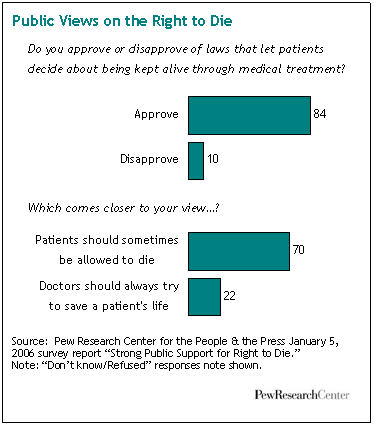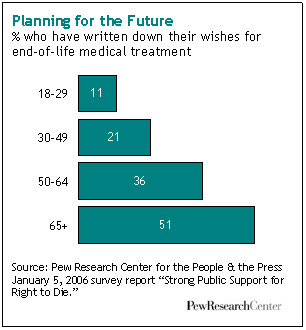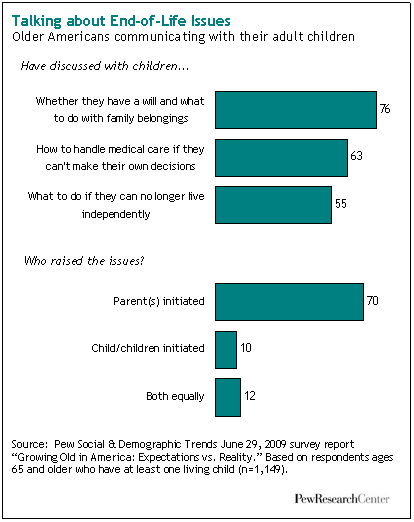The national debate over health care reform has focused new attention on the decisions people make about medical care at the end stages of life.

Public opinion polls show that Americans overwhelmingly support an individual’s right to decide whether he or she wants to be kept alive through medical treatment. In a 2005 Pew Research Center survey, 84% said they approved of laws which say medical treatment that is keeping a terminally ill patient alive can be stopped if that is what the patient desires. In addition, 70% said there are some circumstances when a patient should be allowed to die, while 22% said doctors and nurses should always do everything possible to save the life of a patient.
While a heavy majority of Americans support individual rights in this area, when it comes to personal preferences about medical intervention for oneself at the end of life, the public is more evenly divided. In the same Pew Research survey a narrow majority (53%) said if they were faced with a terminal illness and were suffering a great deal of physical pain they would choose to stop medical treatment, 34% said they would ask their doctor to do everything possible to save their life.
It’s not entirely clear what role the public thinks government should play in these complicated matters. After Congress intervened in 2005 in the case of Terri Schiavo, a brain-damaged Florida woman who eventually died when her feeding tube was removed, there was a significant public backlash. More than seven-in-ten Americans (72%) said Congress should have stayed out of the case, only 17% believed Congress had done the right thing.
In spite of the partisan political debate caused by the Schiavo case, Republicans and Democrats have similar views on the broader issue of whether individuals have the right to make their own decisions about end-of-life medical care. Equally strong majorities of Republicans, Democrats and independents approve of laws that let patients decide about being kept alive through medical treatment. Similarly, views about whether under certain circumstances a patient should be allowed to die do not differ by party. Race and religious affiliation are much more strongly linked to attitudes about the right to die. Among whites, 75% say that there are some circumstances where a patient should be allowed to die. Only 40% of blacks agree. Catholics and white evangelical Protestants are less likely than non-evangelical Protestants and seculars to say patients should sometimes be allowed to die.
Making Plans for the End-of-Life

One way to insure that an individual’s desires about end-of-life medical care are carried out is to put them in writing. Nearly all Americans know what a “living will” is, and most have given at least some thought to their own wishes regarding medical treatment at the end of their life. In the 2005 Pew Research survey, 35% said they’ve given this a great deal of thought and 36% said they’ve given it some thought. Even so, only 27% said they have put their wishes in writing and 29% said they have a living will. Though, this represented a significant increase from 1990 when even fewer — 12% — had some sort of living will. Not surprisingly, older people are more likely than young people to have thought about these issues and to have formalized their wishes. Half of those ages 65 and older (51%) say their wishes for medical treatment are written down and 54% say they have a living will.
Most Americans believe that family members should have a role in end-of-life decision making. A strong majority of the public believes that when a terminally ill patient is unable to communicate his or her wishes about medical care, the responsibility rests with a family member. In the 2005 Pew Research Center survey, 74% of respondents said in this situation, the closest family member should be allowed to decide whether to continue medical treatment.
Do family members who find themselves in this situation know what the wishes of their terminally ill loved ones are? A recent survey by the Pew Research Center’s Social & Demographic Trends project found that among those ages 65 and older with at least one living child, 63% have talked to their children about how to handle their medical care if they can no longer make their own decisions; 35% have not discussed this with their children. Older adults are more likely to have discussed their will and what to do with family belongings than they are to have discussed end-of-life medical decisions (76% have discussed their will with their children).

According to elderly parents, they are most often the ones who initiate these types of conversations. Among those who say they have discussed these topics with their children, 70% say they raised the issues while only 10% say their children initiated the conversations.
Older women are much more likely than older men to have discussed medical decision making with their children (71% vs. 52%). And older whites (66%) are more likely to have discussed this issue with their children than are older blacks (56%) or Hispanics (41%).
In addition to asking older Americans whether they had discussed these issues with their children, the Pew Social & Demographic Trends survey cited above questioned adult children about their communications with their aging parents. Among those adults with at least one living parent age 65 or older, 57% said they have talked with their parents about how to handle their parents’ medical care if they can no longer make their own decisions; 42% say they have not discussed this with their parents. Like their parents, adult children are more likely to say they have discussed their parents’ wills and what to do with family belongings than how to handle their parents’ future medical care.
Daughters are more likely than sons to have had these conversations with their parents: 65% of women vs. 48% of men say they have talked to their parents about how to handle their medical care if they become incapacitated. And white adults with parents age 65 or older are more likely than black or Hispanic adults with aging parents to have discussed this issue.
While a narrow majority of adults (52%) who have discussed these topics with their parents say it was their parents who initiated the conversations, fully a quarter say they themselves brought up these topics. In this way their perceptions differ from the older adults surveyed, most of whom say they are the ones to bring up these sometimes delicate subjects.
Whether or not a provision dealing with end-of-life medical care becomes part of a broader effort to reform the U.S. health care system, this is an issue that affects people of all ages — the elderly themselves as well as their loved ones. And as the U.S. population ages, more families will be faced with these difficult decisions.
About this Survey
Results for this report are from two separate telephone surveys. For both surveys, the data have been weighted to produce a final sample that is representative of the general population of adults in the continental United States. Survey interviews were conducted under the direction of Price Survey Research Associates (PSRA).
The first survey was conducted with a nationally representative sample of 1,500 adults living in the continental United States. The sample for this survey was a random digit sample of telephone numbers selected from telephone exchanges in the continental United States.
- Interviews were conducted November 9-27, 2005.
- Margin of sampling error is plus or minus 3 percentage points for results based on the total sample at the 95% confidence level.
The second survey was conducted with a nationally representative sample of 2,969 adults living in the continental United Sates. A combination of landline and cellular random digit dial (RDD) samples were used to cover all adults in the continental United States who have access to either a landline or cellular telephone. In addition, oversamples of adults 65 and older as well as blacks and Hispanics were obtained. The black and Hispanic oversamples were achieved by oversampling landline exchanges with more black and Hispanic residents as well as callbacks to blacks and Hispanics interviewed in previous surveys. A total of 2,417 interviews were completed with respondents contacted by landline telephone and 552 with those contacted on their cellular phone.
- Interviews were conducted Feb. 23-March 23, 2009.
- There were 2,969 interviews, including 1,332 with respondents 65 or older.
- Margin of sampling error is plus or minus 2.6 percentage points for results based on the total sample at the 95% confidence level.




